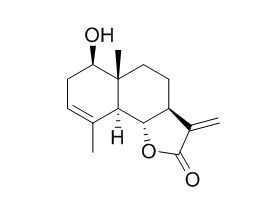Santamarine
Santamarine has significant anticancer activity, can inhibit L1210 cells because of its cytotoxic,cytostatic and blocking mitosis and reducing uptake of thymidine. Santamarine and reynosin show bactericidal activity against clinical strains of Mycobacterium tuberculosis.
Inquire / Order:
manager@chemfaces.com
Technical Inquiries:
service@chemfaces.com
Tel:
+86-27-84237783
Fax:
+86-27-84254680
Address:
1 Building, No. 83, CheCheng Rd., Wuhan Economic and Technological Development Zone, Wuhan, Hubei 430056, PRC
Providing storage is as stated on the product vial and the vial is kept tightly sealed, the product can be stored for up to
24 months(2-8C).
Wherever possible, you should prepare and use solutions on the same day. However, if you need to make up stock solutions in advance, we recommend that you store the solution as aliquots in tightly sealed vials at -20C. Generally, these will be useable for up to two weeks. Before use, and prior to opening the vial we recommend that you allow your product to equilibrate to room temperature for at least 1 hour.
Need more advice on solubility, usage and handling? Please email to: service@chemfaces.com
The packaging of the product may have turned upside down during transportation, resulting in the natural compounds adhering to the neck or cap of the vial. take the vial out of its packaging and gently shake to let the compounds fall to the bottom of the vial. for liquid products, centrifuge at 200-500 RPM to gather the liquid at the bottom of the vial. try to avoid loss or contamination during handling.
Plant Sci.2020, 301:110656.
Mol Med Rep.2024, 29(2):26.
Molecules.2022, 27(19):6681.
Biochem Pharmacol.2023, 211:115502.
Molecules.2019, 24(22):E4022
Appl. Sci.2020, 10(20),7374.
Heliyon.2022, 8(12):e12031.
Naunyn Schmiedebergs Arch Pharmacol.2021, 394(1):107-115.
Int Immunopharmacol.2024, 143(Pt 2):113486.
J Ethnopharmacol.2016, 192:370-381
Related and Featured Products
Cancer Chemother Pharmacol. 2009 Jun;64(1):143-52.
Anticancer activities of sesquiterpene lactones from Cyathocline purpurea in vitro.[Pubmed:
18998133]
Cyathocline purpurea has been traditionally used to treat various diseases including cancers for many years. However, these applications of C. purpurea have not been supported by pharmacological investigation. The objective of this study is to investigate the anticancer activities of three main constituents such as Santamarine, 9beta-acetoxycostunolide and 9beta-acetoxyparthenolide isolated from C. purpurea in vitro.
METHODS AND RESULTS:
Cell viability was determined by trypan blue exclusion and methylene blue assays. Colony formation was assessed by microtitration cloning assay. DNA synthesis was determined by tritiated thymidine incorporation assay. Cell cycle analysis was carried out by flow cytometry. Apoptosis was observed by DAPI staining assay and Caspase 3/7 activities was measured using Caspase-Glo 3/7 assay kit. Santamarine, 9beta-acetoxycostunolide and 9beta-acetoxyparthenolide inhibited the growth of L1210 murine leukaemia, CCRF-CEM human leukaemia, KB human nasopharyngeal carcinoma, LS174T human colon adenocarcinoma and MCF 7 human breast adenocarcinoma cells in vitro, with IC(50) in the range of 0.16-1.3 microg/mL. In L1210 model, Santamarine and 9beta-acetoxycostunolide inhibited L1210 cell growth, colony formation and [(3)H]-thymidine incorporation in time- and concentration-dependent manners. Flow cytometry studies showed that Santamarine and 9beta-acetoxycostunolide blocked L1210 cells in the G(2)/M phase of the cell cycle. DAPI staining and caspase activity assays showed Santamarine and 9beta-acetoxycostunolide induced apoptosis and activated caspase 3 in L1210 cells.
CONCLUSIONS:
These results indicated that Santamarine, 9beta-acetoxycostunolide and 9beta-acetoxyparthenolide exhibit significant anticancer activities in vitro. The inhibitory effects of Santamarine and 9beta-acetoxycostunolide on L1210 cells are cytotoxic rather than just cytostatic. They block mitosis and reduce uptake of thymidine. The mechanism of the cytotoxicity of Santamarine and 9beta-acetoxycostunolide to L1210 cells could be related to alkylation of the sulfhydryl enzymes involved in nucleic acids and protein synthesis, as previously found for other sesquiterpenes with the alpha-methylene-gamma-lactone moiety present in Santamarine, 9beta-acetoxycostunolide and 9beta-acetoxyparthenolide. It may also be related to suppression of microtubular proteins. Santamarine and 9beta-acetoxycostunolide induced apoptosis of L1210 cells via activation of caspase 3.
Pharmaceutical Biology, 2016, 14 May, 54(11):2623-8.
Reynosin and santamarine: two sesquiterpene lactones from Ambrosia confertiflora with bactericidal activity against clinical strains of Mycobacterium tuberculosis[Reference:
WebLink]
Two sesquiterpene lactones (SQLs) with mycobactericidal activity were identified: Santamarine and reynosin.
METHODS AND RESULTS:
Reynosin was the most active compound, with a minimal bactericidal concentration (MBC) of 128 μg/mL against the H37Rv, 366-2009 and 104-2010 Mtb strains and a minimal inhibitory concentration (MIC) of 64, 64, 128, 128 and 128 μg/mL against the H37Rv, 104-2010, 63-2009, 366-2009 and 430-2010 Mtb strains, respectively. Santamarine had MBCs of 128 μg/mL against the H3Rv and 104-2010 Mtb strains and MICs of 128 μg/mL against the H37Rv, 366-2009 and 104-2010 Mtb strains. We also isolated 1,10-epoxyparthenolide but only showed mycobacteriostatic activity (MIC 128 μg/mL) against the Mtb strain. Compounds were tested against the L929 cell line and the calculated selectivity index was <1.
J Pharm Sci. 1978 Mar;67(3):347-50.
Isolation and characterization of the sesquiterpene lactones costunolide, parthenolide, costunolide diepoxide, santamarine, and reynosin from Magnolia grandiflora L.[Pubmed:
641720]
The germacranolide sesquiterpene lactones costunolide, parthenolide, and costunolide diepoxide were isolated from the leaves of Magnolia grandiflora L.
METHODS AND RESULTS:
Costunolide diepoxide might be, at least in part, an artifact derived from air oxidation of parthenolide. The root bark yielded only costunolide together with the two eudesmanolides, Santamarine and reynosin. In an attempt to synthesize costunolide diepoxide, the action of m-chloroperbenzoic acid on parthenolide and on costunolide was studied. The products were costunolide diepoxide from parthenolide and the two cyclized derivatives, Santamarine and reynosin, from costunolide.
CONCLUSIONS:
The elusive 1,10-epoxide was obtained by epoxidizing costunolide using a biphasic system containing sodium bicarbonate. Under these conditions, epoxidation of costunolide took place without cyclization.



